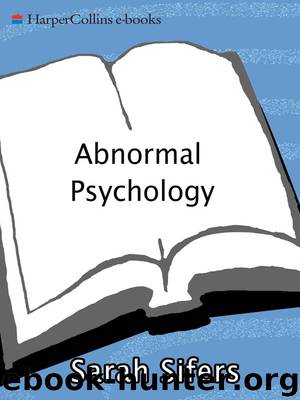Abnormal Psychology by Sarah Sifers

Author:Sarah Sifers
Language: eng
Format: epub
Publisher: HarperCollins
Published: 1992-04-13T16:00:00+00:00
CHAPTER 13
Mood Disorders
* * *
Rare, indeed, are those individuals who are never “in a mood”—downcast, discouraged, even depressed; or on the other hand, elated, optimistic, and energetic beyond one’s usual feelings. It is normal, occasionally, to be down in the dumps, a mood that may be triggered by a disappointment, a promotion not granted, a romantic affair broken off, a disturbing family spat. It is just as normal to go through a period of feeling that everything is rosy, when problems melt away, energy and optimism are high, and much activity, sometimes bordering on the frenetic, goes on.
In the depressed mood, energy drains away, interest in old pleasures wanes, and little is accomplished. In a manic spell, much seems to get done, but not always precisely as planned; new projects are begun, resolutions are made, old projects are finished, high hopes are preoccupying, only to fade away too soon when reality is confronted once again.
Among the general population, these moods have their beginning in some real life situation, and they are terminated by a real life event. Depression disappears after a happy family day or upon receipt of an unexpected compliment. Elation disappears as the reality of life’s problems captures our attention. They are both of relatively short duration, and they lead to no drastic or damaging actions. Such moods are to be distinguished from the extreme moods or mood swings described in this chapter. They are mentioned in order to reiterate a point that has been made before with other psychiatric disorders: Abnormal behavior finds its place on a continuum of behavior from the normal and well-adjusted to the extreme and severely maladaptive.
One other point needs mention here in this introductory statement. The array of diagnoses involving mood disturbances may seem like hair splitting. However, the distinctions made among mood disorders exist because, although on the surface they may seem similar, they represent different disorders that follow their own course, often respond to different therapies and, in extreme cases, lead to markedly different outcomes, including suicide or suicidal attempts.
The chapter first identifies the symptoms of depression and mania, then describes the classification of mood disturbances, and briefly indicates their prevalence. It continues with a discussion of possible causes of mood disorders, and then examines the principal therapies found helpful in their treatment. Finally, it examines the sad phenomenon of suicide, a possible outcome of a severe mood disorder.
Download
This site does not store any files on its server. We only index and link to content provided by other sites. Please contact the content providers to delete copyright contents if any and email us, we'll remove relevant links or contents immediately.
Spare by Prince Harry The Duke of Sussex(5141)
Navigation and Map Reading by K Andrew(5133)
Tuesdays with Morrie by Mitch Albom(4732)
Machine Learning at Scale with H2O by Gregory Keys | David Whiting(4260)
Cracking the GRE Premium Edition with 6 Practice Tests, 2015 (Graduate School Test Preparation) by Princeton Review(4250)
Never by Ken Follett(3884)
Goodbye Paradise(3761)
What It Really Takes to Get Into Ivy League and Other Highly Selective Colleges by Hughes Chuck(3717)
Harry Potter and the Prisoner of Azkaban (Book 3) by J. K. Rowling(3324)
Fairy Tale by Stephen King(3307)
Pledged by Alexandra Robbins(3152)
Kick Ass in College: Highest Rated "How to Study in College" Book | 77 Ninja Study Skills Tips and Career Strategies | Motivational for College Students: A Guerrilla Guide to College Success by Fox Gunnar(3100)
A Dictionary of Sociology by Unknown(3044)
Sapiens and Homo Deus by Yuval Noah Harari(3029)
Reminders of Him: A Novel by Colleen Hoover(3011)
The Social Psychology of Inequality by Unknown(2989)
Graduate Admissions Essays, Fourth Edition: Write Your Way into the Graduate School of Your Choice (Graduate Admissions Essays: Write Your Way Into the) by Asher Donald(2890)
Will by Will Smith(2873)
Zero to Make by David Lang(2753)
